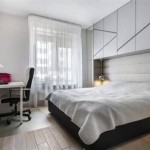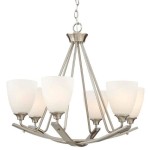Smart Home Decor Ideas 2025: Integrating Technology with Aesthetics
The convergence of technology and interior design continues to accelerate, promising a future where homes are not only aesthetically pleasing but also intelligently responsive to residents' needs. Smart home decor in 2025 will be characterized by seamless integration, personalized experiences, and sustainable practices. The focus shifts from simply adding smart devices to creating a cohesive and intuitive living environment that enhances comfort, convenience, and overall well-being.
This exploration delves into key trends and innovative ideas shaping smart home decor in 2025, examining how homeowners can leverage technology to elevate their living spaces. The integration of technology is not merely about automation; it's about creating environments that adapt to the individual preferences and lifestyles of the occupants.
Personalized and Adaptive Lighting
Lighting is a fundamental element of interior design, and smart technology has revolutionized how it can be controlled and customized. By 2025, expect to see more advanced systems that learn residents' daily routines and preferences to automatically adjust lighting intensity, color temperature, and even the light source itself. This goes beyond basic dimming and color-changing features; sophisticated algorithms will analyze factors such as time of day, weather conditions, and individual activities to create optimal lighting scenarios.
Imagine a living room that gradually brightens as the sun rises, transitioning from warm, ambient light to cool, focused illumination as the day progresses. Or a bedroom that automatically dims and shifts to a red-toned light spectrum in the evening to promote melatonin production and improve sleep quality. Such personalized lighting experiences are enabled by advanced sensors, data analytics, and sophisticated control systems.
Furthermore, lighting fixtures themselves will become more integrated into the overall design aesthetic. Expect to see minimalist, sculptural light fixtures with embedded sensors and connectivity capabilities, blending seamlessly into the architectural fabric of the home. These fixtures will not only provide illumination but also contribute to the overall ambiance and style of the space.
Another facet of personalized lighting involves creating pre-set scenes for various activities, such as "movie night," "dinner party," or "reading time." These scenes can be activated with a single voice command or through a centralized control panel, instantly transforming the atmosphere of the room. The systems will learn from usage patterns, further refining the scenes over time to better match individual preferences.
The environmental benefits of smart lighting are also significant. Automated systems can optimize energy consumption by dimming lights when rooms are unoccupied or adjusting brightness based on natural light levels. This not only reduces energy bills but also minimizes the home's carbon footprint.
Intelligent Climate Control and Air Quality Management
Beyond lighting, smart home systems will also take a more holistic approach to managing the indoor environment, including temperature, humidity, and air quality. Smart thermostats have already become commonplace, but in 2025, expect to see more advanced systems that integrate with other smart devices and sensors to create a truly responsive and personalized climate control experience.
For example, sensors can detect occupancy levels in different rooms and adjust the temperature accordingly, ensuring that energy is not wasted heating or cooling unoccupied spaces. Smart blinds and curtains can automatically open and close to optimize natural light and regulate temperature, reducing the reliance on artificial heating and cooling systems. Furthermore, these systems can learn individual preferences and automatically adjust the climate based on factors such as time of day, weather conditions, and activity levels.
Air quality management will also be a key focus. Smart air purifiers with advanced filtration systems will detect and remove pollutants, allergens, and other harmful particles from the air. These systems can be controlled remotely and provide real-time data on air quality levels, allowing residents to make informed decisions about ventilation and filtration strategies. Furthermore, sensors can detect elevated levels of carbon monoxide or other dangerous gases, automatically alerting residents and taking proactive measures to mitigate the risks.
The integration of climate control and air quality management systems will contribute to a healthier and more comfortable living environment. By optimizing temperature, humidity, and air quality, these systems can improve sleep quality, reduce allergies and respiratory problems, and enhance overall well-being.
The aesthetic integration of these systems is also important. Smart thermostats and air purifiers will be designed to blend seamlessly into the decor, with minimalist designs and customizable finishes. Sensors will be discreetly integrated into walls, ceilings, and furniture, minimizing their visual impact on the space.
Seamless Integration of Technology and Furniture
In 2025, the line between technology and furniture will become increasingly blurred. Expect to see a rise in smart furniture with embedded sensors, connectivity capabilities, and integrated functionality. This goes beyond simple charging ports and built-in speakers; furniture will become an active participant in the smart home ecosystem.
For example, smart sofas and chairs can incorporate pressure sensors that detect occupancy and automatically adjust lighting, temperature, and media playback accordingly. Smart beds can track sleep patterns and adjust firmness and temperature to optimize sleep quality. Smart tables can incorporate interactive displays that provide information, control smart home devices, and even serve as a workspace.
The design of smart furniture will prioritize both functionality and aesthetics. These pieces will be crafted from high-quality materials and designed to complement a wide range of interior styles. The technology will be seamlessly integrated, ensuring that the furniture remains visually appealing and comfortable.
Furthermore, smart furniture will be designed to be modular and adaptable, allowing residents to customize their living spaces to meet their changing needs. For example, a smart sofa can be reconfigured into different shapes and sizes, or a smart table can be adjusted to different heights. This flexibility will make it easier to adapt the home to different activities and lifestyles.
The integration of technology into furniture will also enable new and innovative functionalities. For example, smart mirrors can provide personalized recommendations for clothing and accessories, or smart refrigerators can track food inventory and automatically order groceries. These features will make everyday tasks more convenient and efficient.
Smart home technology will increasingly become invisible, seamlessly blending into the fabric of the home. Outlets will feature wireless charging capabilities, hidden behind minimalist designs. Control panels will be integrated into walls, resembling artwork or decorative features. The goal is to create a living environment that is both technologically advanced and aesthetically pleasing.
Voice control will remain a central element of the smart home experience, allowing residents to control devices and access information with simple voice commands. However, voice assistants will become more sophisticated, capable of understanding natural language and responding to complex requests. They will also be able to learn individual preferences and proactively offer assistance.
Sustainability will be a key consideration in the design and implementation of smart home technology. Energy-efficient appliances, renewable energy sources, and smart energy management systems will play a crucial role in reducing the home's environmental impact. The focus extends to the materials used in construction and decor, favoring eco-friendly and sustainable options. Repurposed and recycled materials, combined with biophilic design principles, are expected to be more prevalent in 2025 smart home decor.
Data privacy and security will remain paramount concerns. Smart home systems will be designed with robust security measures to protect sensitive data from unauthorized access. Transparency and control over data collection will be key, allowing residents to understand how their data is being used and make informed decisions about their privacy.
The integration of smart home technology will empower residents to create living spaces that are truly personalized, efficient, and sustainable. The home of 2025 will be a sanctuary that enhances comfort, convenience, and overall well-being, seamlessly blending technology and aesthetics to create a truly exceptional living experience.
The evolution of smart home decor is intrinsically linked to the ongoing advancements in artificial intelligence, sensor technology, and connectivity. These advancements will continue to drive innovation, leading to even more sophisticated and personalized living experiences in the years to come.

Top 10 Home Decor Trends 2025 Tech Savvy Solutions For Smart Homes

20 Interior Design Trends 2025 Must Have Looks You Ll Love Decorilla

20 Interior Design Trends 2025 Must Have Looks You Ll Love Decorilla

20 Interior Design Trends 2025 Must Have Looks You Ll Love Decorilla

20 Interior Design Trends 2025 Must Have Looks You Ll Love Decorilla

20 Interior Design Trends 2025 Must Have Looks You Ll Love Decorilla

20 Interior Design Trends 2025 Must Have Looks You Ll Love Decorilla

20 Interior Design Trends 2025 Must Have Looks You Ll Love Decorilla

20 Interior Design Trends 2025 Must Have Looks You Ll Love Decorilla

Smart Furniture Latest Innovation Design Ideas 2025
Related Posts







